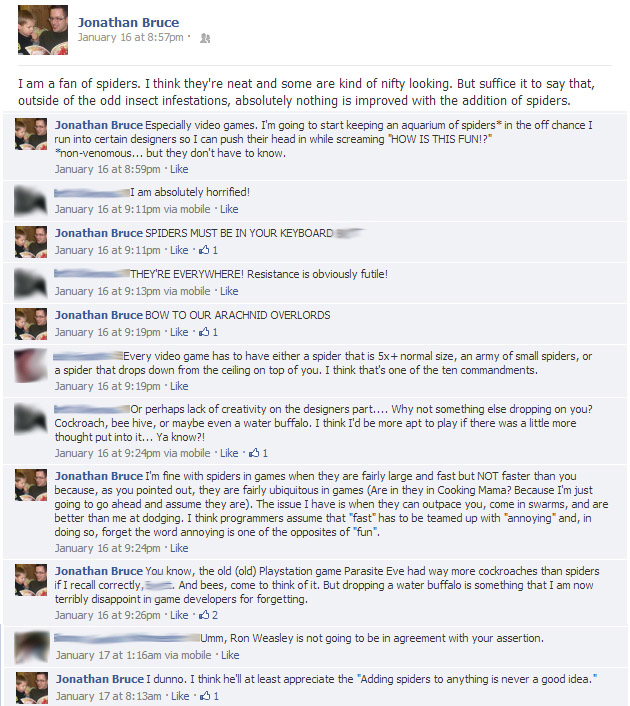On the Subject of Spiders
I like spiders. I think they are neat and useful. And, yes, in my weirdest moments, I think they’re kind of cute in an eight-legged, dead-eyed monstrosity kind of way. I will never own one as a pet, and I would prefer if they keep a respectable distance between us. But at the end of the day, I don’t suffer from the instant-terror that other people do.
This is not a post about how I’m an arachnophile. No, this is a post about video games.
As a friend of mine pointed out, video games seem to be under a contract with the spider lobby to have parts in every game ever.

You wish you were as cool as me.
In many cases, these are horror games that aren’t very scary that seem to be under the impression that spiders will automatically make up for any deficit in atmosphere, acting, writing, and general enjoyment. And while I will agree that there is something “off” about a horrific amalgamation of spider and something else, the results are less The Thing and more “We add spiders... only they’re huge!”
It’s such an amazing lack of thought. We live in an era where enemy designs are limited by the imagination, and yet we have fucking spiders as the go to monster for countless genres. Now, in general, this is just boring as opposed to outright annoying. It’s when the spiders are tiny that there’s an issue.
The reason why spiders the size of cats or so are such shit enemies is that, in the effort to actually make them threats, programmers tend to make them faster than the player. And then they go and make self-defense an annoying proposition. In Doom 3 for instance, you have a game where the spiders fucking dodge bullets, can close the distance faster than you can change to a weapon that’s useful, and when they hit you (and they will hit you) your screen jerks wildly, throwing off your aim and guaranteeing a free couple of screen-jarring hits as your brave space marine stares at the ceiling.
See, I’m very much so of the idea that games are supposed to be fun. They can be challenging, yes, but if an enemy isn’t actually an enjoyable part of the game, then why is it there? It’s like designers want a fast monster and they automatically associate the word “fast” with “annoying” which is one of many words in direct opposition to fun. If the player has no effective means by which to defend him or herself against an enemy, it should stand to reason that the enemy either shouldn’t exist or should be relegated to being a gatekeeper until the player acquires the means to defeat them.
As much as I love the game The Binding of Isaac (I’m actually listening to its soundtrack as I write this), its expansion pack, Wrath of the Lamb, is very much so guilty of this. In a game with a myriad of horrifying and challenging (and, at times, frustrating) enemies, the spiders are far more obnoxious than they have any right to be. There’s no real pattern to their movement, they can phase through walls when the AI hates you (and the AI always hates you), and their hit boxes are small enough that if you miss, Isaac’s going to be dogpiled.
The Binding of Isaac was always a tough game, there’s no doubt about that. But the addition of fast, bullshitty enemies like spiders made that challenge feel less legitimate (i.e., an obstacle that can circumvented through skill) and more like your success depends more on luck. I suppose it fits in with the rogue-like gameplay of randomly generated powerups that can completely fuck you over (like the time I mixed an explosive shot with a boomerang one and ended up blowing myself up), but at the same time I feel like all this creative energy went into the production of an awesome game and the words “Fuck it, add spiders,” were muttered toward the end of it. What’s particularly odd about it is that the game includes at least one significantly unique spider-like design – the Triachnid/Daddy Long Legs boss fight – which provides a unique spin on things (even if one of the attacks is to hack up more fucking spiders). Long story short, I could deal with the frustrating nature of the entire game up to the addition of spiders – even the cheapest monster attacks were mitigated by the interesting design except in the case of boring arachnids.
So, can spider-like enemies be done well? Oh, yes they can. There’s a small game you may never have heard of called Half-Life which features a beastie called a headcrab. They’re about the size of cats, leap at your face, and in general fill the role of low-level threat. The reason the headcrabs work as an enemy in terms of basic design is that they’re screechy near-spiders – they’re extraterrestrial, aggressive, and visually different from what we’re used to. They’re easily visible at a distance and, unless you’re critically wounded, are very unlikely to pose a significant threat. Their function is to add depth and atmosphere.
In the even less heard-of sequel (titled, imaginatively enough, Half-Life 2) two additional types of headcrab find their way into the game world. The fast headcrab is dangerously close to being a frustrating waste of code – they’re speedy, aggressive, and dodge. However, this is not a problem as if they hit you, your view doesn’t end up skyward, a la Doom 3. The damage output is fairly minimal, although there is the potential for swarming behavior. Also, they dodge after they’ve been hit because they are dumb animals as opposed to psychic banes of your existence. Having to correct your aim after a successful shot is not nearly as aggravating as wasting ammunition putting a new pockmark in the floor moments before having your sexual organs worn as a hat by a mutant.
The other addition is a poison headcrab that knocks your health down to 1 in a single blow. You get your health back over ten seconds or so, but you have to basically run around like a spaz to make sure no other monster manages to disembowel you in that time frame. And while you may think this is a perfect example of what not to do, once again the designers of the game know how to balance challenge with fun. The little bastard produces a rattling-warning noise like a rattlesnake. The sound cue warns that shit is about to get very real. While the other headcrabs can actually get the jump on you and knock off a couple of health before you can react, the poisonous bastards are fairly kind in the regard that they give you some time to find them and smear them all over the floor. And, in another move of genius, these monsters can’t actually kill you (I think). They can reduce your health to critical levels and keep it there with subsequent attacks, but it will take another enemy to actually land the killing blow. It’s a nice mechanic and allows for an effective mixing of enemies.
And not to keep harping on how the makers of Half-Life know what the hell they’re doing, but even when an enemy is annoying, it’s an actual pest rather than a threat. In the sequel, the player has to do battle with a tripod on loan from War of the Worlds. You take cover in either a destroyed office building or car park and dash between cover, dodging machine gun fire and floating cameras acting as spotters. The cameras produce a blinding flash, but do not actually cause any damage themselves. Outside of one moment where I grabbed one out of the sky and screamed “YOU KNOW WHAT YOU DID!” before hurling it into a wall, the sequence was hectic, not frustrating. The harrying enemy force couldn’t be ignored, and after that one particular battle, the little bastards pretty much stayed out of the way.
But going back to the topic of spider-like enemies, the original Devil May Cry had a recurring boss fight with a giant magma-spider-demon-thing named Phantom. First and foremost, Phantom didn’t have boring web-based attacks, substituting sticky goo for flaming liquid rock. It also had a semblance of a personality (and a lisp) in cut scenes, making encounters with him slightly more unique than a series of trash mobs. Now, yes, Phantom was basically a giant spider with a rock-and-lava theme. But the encounters with him were generally exciting and fun because – and I can’t stress this enough – there was only one of him.
And just before I was going to post this, I suddenly remembered that there is a large spider boss fight in Doom 3 that I had forgotten about. The Vagary boss is a human woman/spider combo that has little build up, dies in under a minute, and is pretty much forgotten about immediately. I included this information because I had just replayed Doom 3 about a month ago and the boss fight is significantly less memorable than the annoying, ankle-biting spiders. Why is that? Well, outside of some cocooned (or whatever the term is) human window dressing, the beast is barely acknowledged before or after the encounter. This is important: Doom 3 had the pretension of a story and it counted on monster-design (as boring as it is in this case) to do the writer’s job. A simple radio-dialogue where a team is wiped out, or an SOS call from a trapped scientist, or any number of alternate ways to build up something is lost because spiders are the default, bullshitingly lazy “creepy” monsters. The uninspired boss fight just makes me thinks that the space marines are woefully incompetent or – more likely – demonic spiders are just as much of a non-entity as real ones are.
Compared to Phantom of Devil May Cry (who, I might add, I remember after almost ten years of not playing the game), Vagary is the perfect example of why spiders on a large scale typically don’t work. You see, Phantom is a demon whose physical shape is incidentally that of a spider. Fighting him isn’t fighting any other enemy, it’s fighting Phantom. Effort was made to make the boss encounter unique and it works because I’m not supposed to be scared of him. Vagary, on the other hand, is a generic monster who is only “intimidating” because it’s a spider (or, you know, a fucking drider). You handle it the same way as every other monster: by pointing your cursor at it until it stops moving. Just like the Arachnotrons and Spider Masterminds of the original Doom and Doom II, the monster design could have been a strolling wad of wet toilet paper and it would have made no difference in how the game was played. The fact that they were spider-like was supposed to trigger something in the player, but it never extended beyond the monsters’ appearance. In the case of Devil May Cry, effort was put in to give the thing a personality, which made the thing actually memorable. In Doom 3 and most other games, the fact that a spider is a spider is supposed to make the things memorable.
You see, spiders in games just really aren’t that fun. If there a low-level enemy, they’re boring because they offer the same lack of innovation in almost every game they’re in. If they do pose a significant threat and are standard monsters, it’s usually because there’s about a million of the goddamn things and it’s more death by papercuts than an actual challenge. Every once in awhile, you get a unique spin on it – Phantom, the headcrabs, Daddy Long Legs/Triachnid – but for the most part, it’s just a bad idea. Effort has to be made to actually give the monsters some kind of trait other than “spindly legs,” “poison,” or “undying hatred of a character’s ankles and groin.” Phantom whined because the hero of Devil May Cry wasn’t large enough to sate his hunger. The headcrabs can still startle a fully-armed and armored player. Both the Daddy Long Legs and Triachnid try to smash the player underfoot. But for the most part, spiders are a laundry list of what not to do in games. They are seldom fun to fight or a significant challenge, nor are they in any way memorable. And even if the fights are memorable in a good way, the spiderishness is usually incidental. I do not remember a single person ever saying “This game was shit until I got to the part with the spiders.” It’s usually the opposite if spiders are even mentioned at all.
As the final word on the topic, I think this explains it fairly well:

TWEET
< PREVIOUS ENTRY • NEXT ENTRY >
Advice • Fiction • Gaming • General Musings • Reviews





